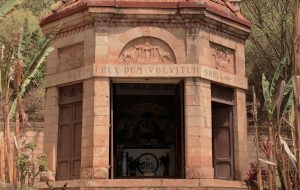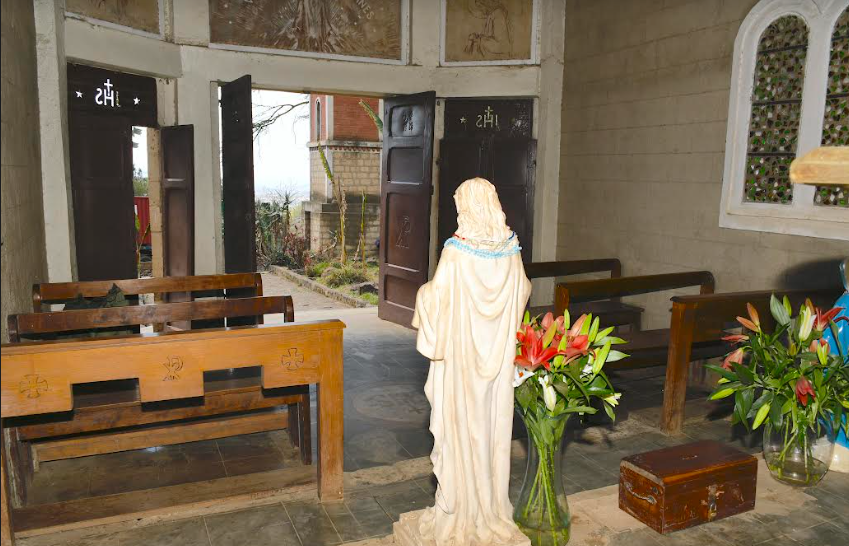The Catholic Church, also known as the Roman Catholic Church, is the largest Christian denomination, with a membership of 1.3 billion baptized faithful worldwide. This is according to the Roman Catholic data of 2019.

It is among the world’s oldest and largest international institutions, and has played a prominent role in the history and development of Western civilization.
As a branch of the Christian faith, Roman Catholicism can be traced to the life and teachings of the Lord Jesus Christ in Roman-occupied Jewish Palestine about 30 Century A.D.
According to Roman Catholic teaching, each of the rituals performed by the church was instituted by Christ himself. Roman Catholicism also holds that Jesus established his disciple St Simon Peter as the first pontiff of the budding church. This is according to the book of Mathew in the Bible chapter 16 verse 18 (Matthew 16:18).
Along the Nairobi-Mai Mahiu Road lies a church at the foot of a steep escarpment, one of the oldest Catholic Church buildings constructed by Italian prisoners of war in 1942 while working on the construction of the Rironi – Maai -Mahiu Road that snakes through the escarpment.
The prayer house was set up by the prisoners for their own worship when they had a break from the construction work, perhaps to comfort themselves from the hustle and bustle of their lives as prisoners.
Regarded as one of the smallest church buildings in Kenya and arguably in the whole African continent, the chapel often referred to as “Travelers Chapel” in Mai Mahiu measures 15 by 8feet, accommodating only about 12 people at a go on four benches, but boasts of a rich history and culture fused with Italian architectural heritage.
Due to this rich history, the chapel has over the years served as a place of worship and tourist attraction site for many who want to share in its rich history. The church is a site to behold with its Italian architectural design, but has had its own fair share of challenges that threatens its rich cultural and historical existence.
As we walk in, we are met by Ann Nyakio, one of the three staffers tasked with the responsibility of taking care of the church by the Italian Embassy in Nairobi.
She narrates to us that burglars have in the past managed to steal wares from the church ranging from the metallic gate installed at the entrance, antique windows and the church bell stolen in 1980 which she tells us was made of gold, making it a soft target for thieves with an appetite for quick cash.
According to Ms. Nyakio, one of the most notable losses in the House of God is the theft of the ancient scroll bible in 1980 which was used by worshippers and has since been replaced by the modern-day protestant and catholic bibles. She explains that vandalism has threatened the existence of the original design features of the church as conceptualized by the builders.
Another notable thing a worshipper or visitor will be quick to note upon entering the church is the absence of electricity connection in the chapel, however the caretaker says insecurity has been the greatest impediment towards installation of electricity in the church, as vandals or thieves will target the critical power components.
This has impeded operations at the chapel. Nyakio says some worshippers would love to use the space at night but due to the lack of electric power connection, this has pushed away potential pilgrims therefore hindering the extension of operating hours into the dark.
Apart from lack of electricity connection, the emergence of Covid-19 pandemic in 2020 greatly affected the number of visitors to the church therefore witnessing a sharp decline with the peak season which starts from July to December every year having recorded an average of 100 tourists in 2022 compared to the over 200 hundred people a year during pre-covid times.
Nyakio is however optimistic that the trend will change in 2023 and revert to normal operations.
On January 1st of every year, Nyakio who has worked at the church for more than 10 years says Italians living in Kenya and visitors from abroad congregate at the famous church to conduct their annual memorial Mass in remembrance of the soldiers. Considering the small size of the church with only four benches, she says faithful are forced to carry their own extra seats if they exceed the number of the people who can be accommodated by the available pews in the church.
According to our host, the church initially at its conception did not have the current four benches but was rather an empty hall where Italians used to kneel down during worship hence the nickname ‘Msikiti’, which translates to Mosque, a place of worship for Muslim faithful. This necessitated the Italians to return in 1985 to install the benches in order to give it “a church face” with the four wooden benches.
The Church which sits on a two-and-half-acre piece of land also plays host to the final resting place of some of the Italians who died in the country while serving their terms as prisoners of war.
As Nyakio takes us through the church compound, she singles out one of the graves at the entrance of the premises holding the remains of one soldier where she explains the presence of a large aloe vera plant saying, it was planted on the grave according to the wishes of the soldier to symbolize the pain and struggle he underwent while slaving in the Kenya.
Back inside the church, one of the easily noticeable features are the writings inscribed on the walls in italics begging the question as to why the authors chose to use Latin language and not English?
Nyakio breaks down the reasons behind all that and takes us back to 1939 when the British captured the Italian soldiers and brought them to work on the Mai Mahiu road with no machinery explaining the meandering nature of the escarpment road.
During that period, the soldiers faced a lot of struggles and as they built their church, the Italians opted to use Latin in order to conceal their communication from the British soldiers guarding them.
Standing on the pulpit while facing the entrance starting on the left hand side, these words ‘enite Ad Memone’, which means ‘Come to me, my People’ will capture your attention, ‘Haec Est Victoria Quae Vincit Mundum Fides Mustra’; on the same wall means that ‘This is the victory that has won the world by our faith’. Another writing; ‘Benedicite Coeli Domino Benedicite’ means ‘Blessed be the sky and blessed again’. Other writings include; ’Germinatia In Terra Domino Universa’, which means ‘everything will germinate in the sky and on the earth’’.
These writings take you into the minds of these Italian soldiers as they served their prison terms in anguish.
Our conversation with Nyakio is briefly interrupted with the entrance of one visitor who gracefully agrees to speak to us after finishing his prayer. John Maucho who hails from Kisii County but resides and works in Nairobi explains that he has been visiting the church every time he is on his way home and back to Nairobi for over 25 five years.
Maucho who frequents the place together with his family notes that the church has witnessed minimal changes with renovations done intentionally not to change the look of the church but to maintain the original architectural structure as envisioned at its conception.
He encourages people from all walks of life to visit and worship for free at the church as they learn the rich history and experience what was left behind by Italian prisoners of war.
As we wind up our tour, Nyakio reveals that the church has played host to prominent figures in the public who have come to seek divine intervention with the most notable being First Lady Rachel Ruto, former First Lady Margaret Kenyatta, former Cabinet Secretary Eugene Wamalwa as well former Chief Justice Willy Mutunga among others.
All said and done, the church is a unique historical structure that should be preserved and protected for posterity.
By Mabel Keya – Shikuku





